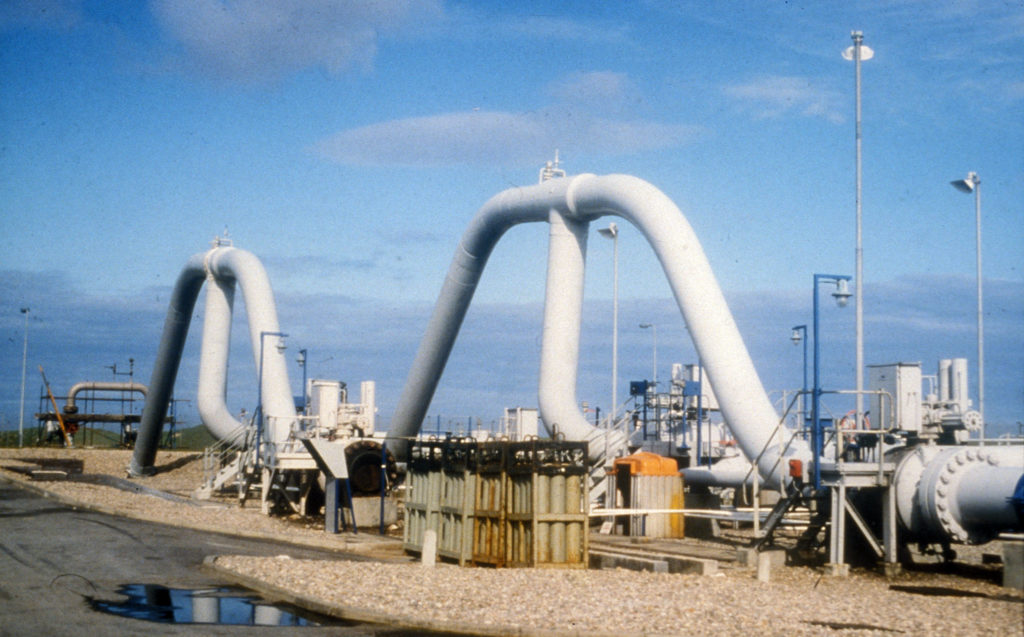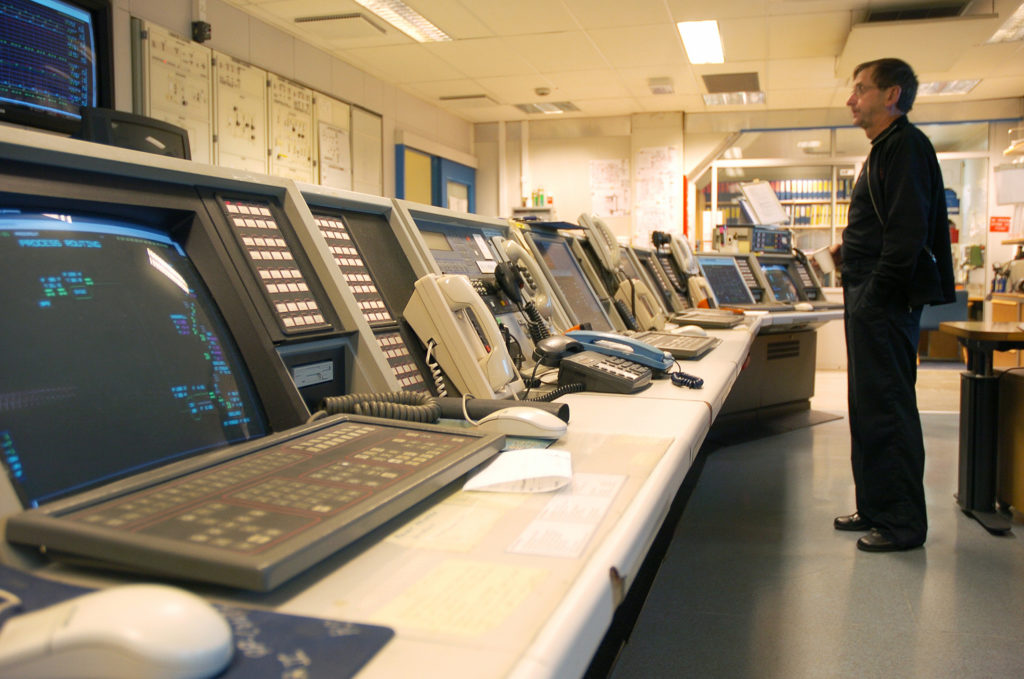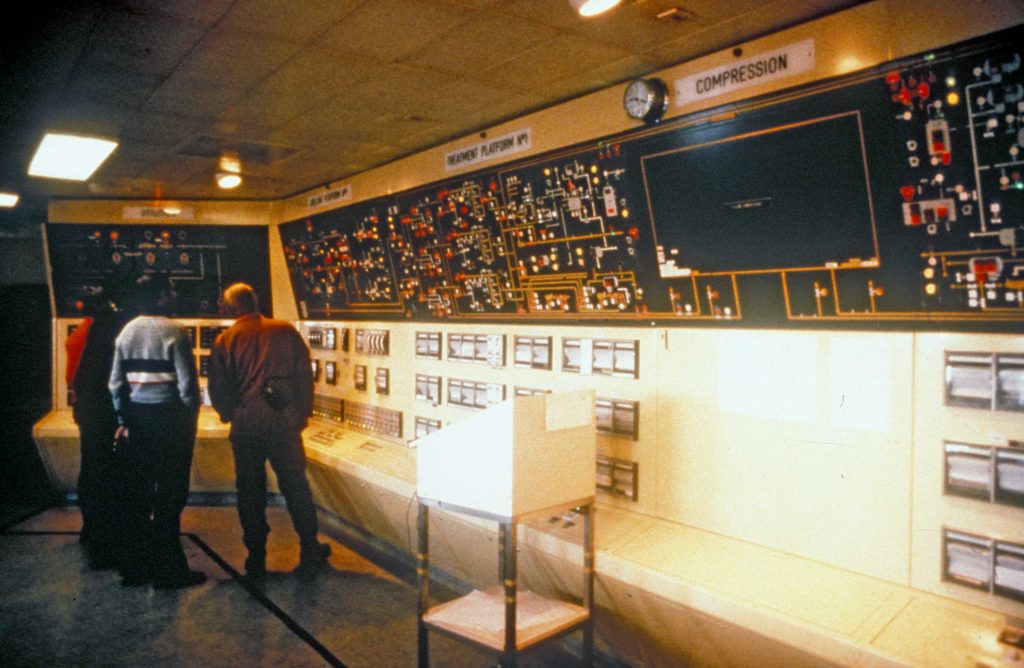Control room operators

If any of the equipment suffered a functional fault, production could continue through reserve lines to avoid a shutdown. A lot of the operators’ time was devoted to observation and to keeping an eye on alarms. A senior operator was in overall charge of the CCR. This person’s duties included issuing work permits and permits for hot work. The senior operators changed on Tuesdays, and the other operators on Thursdays. This preserved continuity in the CCR across tours. Most of Frigg could be remotely operated from the CCR, including the satellite fields.
 Operatør bore- og brønnhodeplattformene, drift,
Operatør bore- og brønnhodeplattformene, drift,One of the main responsibility of the operators was to control the wells and the flow of gas. Adjusting a choke valve on each well would increase or reduce the level of output. Wells could be shut down from the CCR, but not reopened. That job had to be done manually on the drilling platforms.
As a safety precaution, three parallel production lines ran from the wells to the flowlines which connected with the processing platforms. In principle, these lines were independent facilities and complete in themselves. Under normal operation, production was run through two of the lines, while the third was on standby. In the event of maintenance or a fault in one of the lines, production could be switched over to the standby system. Shutdown tests were run at least once a year to check how parts of the plant behaved under shutdown and start-up. The production lines were tested one by one, with two always remaining in operation.
 St Fergus gassterminal, forsidebilde, frøy,
St Fergus gassterminal, forsidebilde, frøy,Frigg had no gas storage, so the actual transport system functioned as a buffer zone. In general, gas deliveries were adjusted once a day from the CCR. Every evening at 18.00, a nomination telex was received for the following day’s gas volume. Adjustments could also occur during the day. The CCR operators communicated on a direct line with the St Fergus terminal. Pressure was constantly adjusted in line with gas requirements in the UK, with the desired level specified by the receiving end in St Fergus. If pressure had to be adjusted, the CCR operators notified the process operators about what was to be done. Most of the contact with St Fergus concerned the quantity of gas to be delivered. Torbjørn Olsen, who spent many years as a control room operator on Frigg, reports that most of the personnel in St Fergus were Scots employed by Total UK. A number of the control room staff tried to avoid communicating with their Scottish opposite numbers because their dialect made them hard to understand at times. As a result, contact with St Fergus was largely maintained by the senior operator.
The CCR had opportunities to display information about every well. Since the mimic panel only showed two wells at a time, the others were presented on smaller screens. When the satellite fields were tied back from the 1980s, the control system was changed to a computerised solution and the mimic panels were partly replaced by computer monitors. Although many functions eventually became computerised, the production operators still had to open and shut valves manually in the old plant. However, a complete overview of all valves was available only in the CCR. Communication between the CCR and the process operators was always critical for safe operation of Frigg.
 arbeidsliv, Kontrollromsoperatør
arbeidsliv, KontrollromsoperatørTo begin with, a sharp separation of functions prevailed between the CCR and process operators. People either worked in the process or in the control room. During the 1980s, however, a rotation system between these activities was introduced. Operators spent a week in the control room and a week in the process.
The CCR also functioned as a space for social interaction and as a meeting point. Since their offices were next door, the field manager and safety supervisor often popped in. Fruit and coffee was constantly available in one corner. There were fixed coffee breaks at 09.00 and 15.00, when many people dropped by the control room. This made it an informal meeting place, where both work and personal matters were discussed.
 Kontrollrom på QP, drift,
Kontrollrom på QP, drift,Work in the control room might have appeared relatively monotonous and boring to some people, with little happening. Production on Frigg was very stable. The operators nevertheless had their challenges, particularly when phasing in the satellite fields. Frøy posed a number of major issues, for instance. This was Elf Norge’s first oil field, and the operators had to learn a new type of process when it came on stream. Frøy offered different production challenges than gas operation. Output was not as stable as on the main field, for instance.
While the North-East Frigg, Lille-Frigg and East Frigg satellites were in operation, dedicated operators focused on running these fields and production could be controlled from the CCR.
